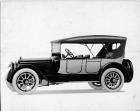|
Re: New replacement radio for 55/56
|
||||
|---|---|---|---|---|
|
Home away from home
|
It's something I learned decades ago (provably in the '60s) and don't recall the source so perhaps one of the electrical engineers here can explain it better but I'll try to paraphrase. It's to do with how readily electricity can travel based on surface temperatures. It apparently travels more readily from a hotter surface so on a positive ground vehicle, the spark is traveling from the cooler center electrode to the hotter tip point so needs a closer gap to be able to do it. On negative ground, the spark is from the hotter point to the cooler center electrode so a wider gap is needed.
Posted on: 2016/8/8 11:43
|
|||
|
All generalities are false.
Once I thought I was wrong but I was mistaken. Don Pierson Packard / IMPERIAL page CA DMV Licensed Vehicle VIN Verification 1951 Henney-Packard 3-Door Long Wheelbase Air Force Ambulance The 1951 Henney-Packard is For Sale! 1954 Packard Patrician 1954 Packard Patrician Parts Car 1956 Clipper Custom Sedan |
||||
|
||||
|
Re: New replacement radio for 55/56
|
||||
|---|---|---|---|---|
|
Home away from home

|
HH56 Quote:
change the wires at the coil so the terminal on the coil going to the distributor points matches the battery ground. Good technical explanation Howard, but in actuality all one has to do is just switch the wires on the coil when doing a polarity change. I did this on my 55 Pat. But at the same time, I added an MSD-5 "multispark" capacitive discharge box hidden in the P-side fender. I removed the ballast resistor on the firewall as it was not needed to reduce current because the MSD-5 box draws almost no current. I have not changed points ever since doing this in 2000. But, one has to occasionally check the dwell because the rubbing block on the points does wear some. Craig
Posted on: 2016/8/8 15:05
|
|||
|
Nuke them from orbit, it's the only way to be sure! Ellen Ripley "Aliens"
Time flies like an arrow. Frui |
||||
|
||||
|
Re: New replacement radio for 55/56
|
||||
|---|---|---|---|---|
|
Webmaster
|
Just a note of correction: A ballast resistor's main purpose is to reduce voltage, not current (amperage).
Posted on: 2016/8/8 15:33
|
|||
|
-BigKev
1954 Packard Clipper Deluxe Touring Sedan -> Registry | Project Blog 1937 Packard 115-C Convertible Coupe -> Registry | Project Blog |
||||
|
||||
|
Re: New replacement radio for 55/56
|
||||
|---|---|---|---|---|
|
Home away from home

|
BigKev: Ballast resistor function: Resistance reduces downstream, i.e., if you have enough resistance (like an infinite resistance open circuit), one gets none of either. So I don't understand your answer. Please clarify.
On Edit: There is the "power loss" equation "PL = I^2R" which states that the electrical power converted to heat (both are energy, therefore are equivalent) varies as to the square of the amperage (I), but only the first power of the resistance (R). So to cut down on energy loss, increase the resistance which will reduce the voltage AND the current, both of which reduce the energy loss. 2nd Edit: Using Ohm's law, I = V / R, so the current varies as to the inverse of the resistance. Hence, if one increases the resistance with the same voltage (12V in a battery automobile), then the current goes down. Voltage (12V) does not change, but current varies as to the resistance in an inverse relationship. Factor that into my above edit. BTW, it is current, not voltage that "burns points", due to electrons passing from one surface to the other. Craig
Posted on: 2016/8/8 17:25
|
|||
|
Nuke them from orbit, it's the only way to be sure! Ellen Ripley "Aliens"
Time flies like an arrow. Frui |
||||
|
||||








